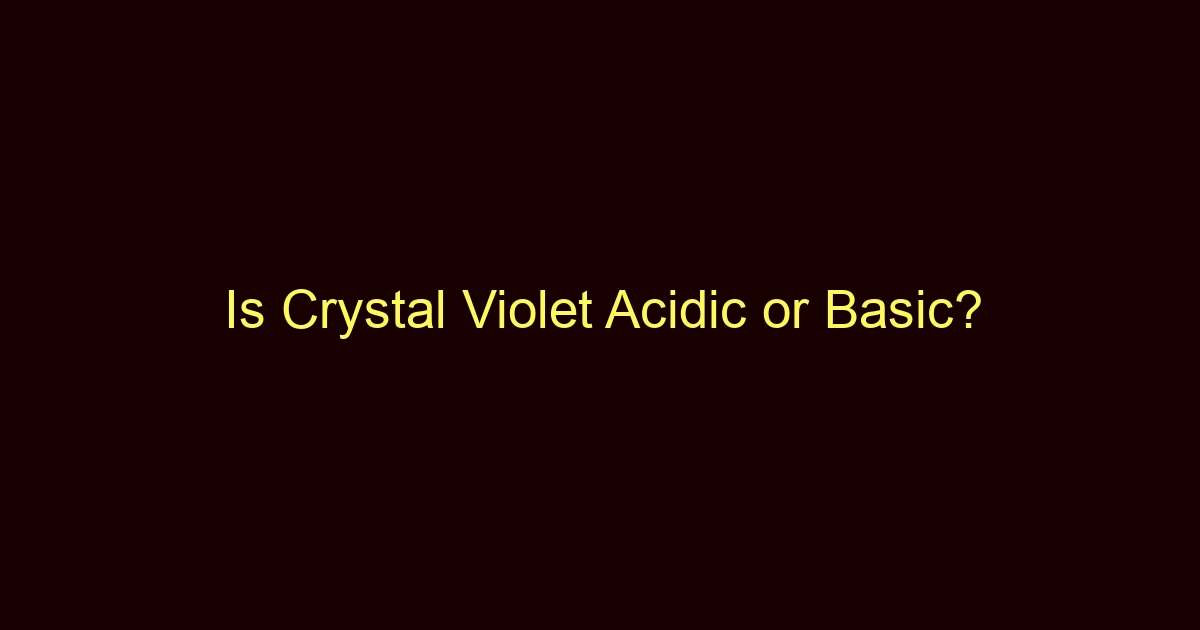Crystal Violet is a basic dye, as it is cationic and binds to negatively charged materials, often used in staining procedures in microbiology.
Crystal violet, also known as Gentian violet, is an intriguing compound with a spectrum of uses, from medical treatments to research applications. Known primarily for its role in Gram staining in microbiology, this triarylmethane dye has unique chemical properties that lend itself to various applications.
In this article, we dive into the question that’s been on many people’s minds: is crystal violet acidic or basic? Well, don’t go anywhere, because we’re about to unravel this scientific enigma.
Is Crystal Violet Acidic?
No, crystal violet is not acidic. It’s actually a basic dye.
You might be scratching your head right now, wondering how a dye could be classified as basic. The answer lies in its chemical structure and behavior. Crystal violet is cationic, which means it carries a positive charge. Acidic compounds are generally anionic, carrying a negative charge. The positively charged ions in crystal violet tend to attract negatively charged particles, such as bacterial cell walls.
Let’s dig a bit deeper. In the world of microbiology, Gram staining is a common technique used to differentiate bacterial species. Crystal violet is often used in this process because it binds well with the peptidoglycan layers in bacterial cell walls, which are negatively charged. Because it is cationic, it’s much more inclined to bind with these negatively charged materials, making it a basic dye.
Ever wondered why your science teacher kept stressing the importance of charges in chemical reactions? Well, this is a prime example. The cationic nature of crystal violet makes it basic, not acidic. So, the next time you’re performing a Gram stain, you’ll know exactly why you’re using crystal violet.
Is Crystal Violet Basic?
Yes, crystal violet is a basic dye due to its cationic nature.
The term “basic” in the context of dyes like crystal violet doesn’t relate to pH but rather to its ionic properties. Unlike acidic dyes, which are negatively charged (anionic), basic dyes carry a positive charge (cationic). This allows them to bind more easily to materials that have a negative charge, such as cell membranes and DNA.
You see, in the molecular dance of life, opposite charges attract. That’s why crystal violet, a basic dye, is used for staining negatively charged cellular components. Ever tried fitting two puzzle pieces that just don’t go together? That’s what happens when you try using an acidic dye on a negatively charged structure. They repel each other, like two magnets with the same pole facing each other.
Imagine crystal violet as the charismatic individual at a social gathering, easily mingling and forming bonds. Its cationic nature makes it attractive to negatively charged surfaces like a social butterfly effortlessly making connections. That’s what makes it a basic dye, integral for various staining procedures in scientific research.
pH Values of Crystal Violet
When discussing the pH of crystal violet, it’s important to note that the compound itself doesn’t have a pH. Rather, the solution in which it is dissolved will have a pH value. Typically, crystal violet solutions are mildly basic to ensure optimal staining results.
Final Thoughts
In summary, crystal violet is a basic dye. Its cationic nature allows it to interact beneficially with negatively charged materials, making it a cornerstone in scientific research and staining procedures. The next time you come across crystal violet in a lab or read about it in a study, remember that its basic character plays a vital role in its utility.
The intricate ballet of positive and negative charges in the microscopic world is fascinating, isn’t it? Who would have thought that something as simple as charge could play such a significant role in our understanding of biology? So, the next time you find yourself grappling with the complexities of chemistry and microbiology, just think about crystal violet a simple yet incredibly versatile dye that stands as a testament to the wonders of science.

